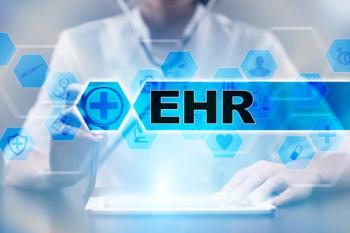
- October 25, 2018 edition
- Volume 95
- Issue 20
A young physician’s view on EHRs
EHRs don't work well enough.
In the brief span of my medical school and residency training I was exposed to 16 different electronic health records (EHRs), as well as paper charting.
Ironically, I found that the easiest to use, most comfortable, and best experience was the paper record. Everything else felt clunky, unintuitive, and disruptive to the patient-physician encounter. Digitizing health records increases communication, continuity, and long-term tracking of illness. But for this millennial trainee who is facile with technology and has a background in computer networking, the sum of my experiences with EHRs have left me simultaneously overwhelmed and unimpressed.
And here’s the kicker: Starting my first job as an outpatient primary care physician, I was introduced to my 17th EHR.
How EHRs obstructed learning
In my experience, exposure to the EHR during medical school obstructed both my learning and the training environment. Routinely, I would arrive on my first day of a new rotation to find lack of access to the medical record system and patient information. Obtaining access was always coupled with hours or days of formal training on the nuances of the EHR. In the span of a two-or four-week rotation, this represented precious time away from the bedside. Thereafter, I experienced at least a week of fumbling through a foreign system before understanding the processes, anomalous places to click, and complex orders that almost never paralleled other systems. In effect, the impact of the EHR on my training was more a lesson in responding to change and decoding a dysfunctional medical record system than an actual enhancement of clinical experience.
I was in medical training between 2008 and 2015; my hope is that with EHR consolidation, such experiences are less common. Yet I suspect that EHRs remain disruptive to the training environment. Even the most advanced current EHR systems have incongruous inpatient, outpatient, surgical, and imaging interfaces. Month by month, trainees are still left to contend with the challenge of understanding the computer interface before patient care.
Frustration with EHRs is not limited to senior physicians. It is transgenerational and extends from misapplication of outmoded technology. I have yet to meet a young physician colleague or trainee who has displayed any emotion greater than lackluster contentment with their medical record system.
How EHRs will improve
I envision three major themes for EHR improvement: advancement of usability, care enhancement capability, and supportive infrastructure. The first requires updating technology, revolutionizing interfaces, and easing data entry and extraction. The second theme is already underway in some settings, and involves enhancing digital interaction to extend beyond the documentation of episodic encounters.
Such capability would include integration of population management, digital and remote monitoring of patient data, and real time updating of clinical information and guidelines.
The third major theme involves the systems, people, and processes that are built around EHRs. This supportive infrastructure is responsive to changes in payment, policy, regulation and documentation requirements that are layered into the healthcare system.
One major, yet necessary, fix depends upon coordinating interoperability between systems. In my free time outside of my busy medical practice, I can instantaneously video chat a friend across the globe easily, for little cost, and with good fidelity. Yet I am frequently foiled in efforts to garner even simple notation on care from the walk-in clinic across the street from my practice.
Such fragmented communication remains far too commonplace. It cripples continuity, leads to soaring costs and duplicative work, and engenders uncertainty in physician decision making and patient care. I fully appreciate the complexity and challenge in meeting the goals of interoperability, not to mention the cost, but a sane healthcare system demands it.
The future of EHRs
I anticipate that we will see a disruptive innovator-the kind that has arrived in almost every other industry- that will be able to provide a better EHR product, at a far more reasonable price and improved ease of use. In terms of the current market, there have been so few new players on the scene, and those that do exist charge kingly prices to implement and maintain their systems. I anticipate we will see an Uber of EHR, given the expansive marketplace, financial possibilities, and creative genius of Silicon Valley and elsewhere. Many should be eager to take advantage of an uninspiring and frequently frustrating healthcare environment.
On the horizon, physicians should anticipate the implementation of voice recognition software with smart learning and artificial intelligence (AI). This will allow audio recording of an entire encounter, with construction of relevant history points, physical exam notations, and assessment and plan into a digestible, structured, and cohesive document.
Imagine immediate creation of a patient handout at the conclusion of any encounter that summarizes and condenses salient points and plans as they are vocally conveyed to the patient in real time. A similarly generated documented summary of the visit in written form can be reviewed by the physician prior to finalizing and signing.
At this very moment Amazon’s Alexa software can instantaneously tell me the score from the 1960 NFL championship game, and provide details of the date, hour and place of the game in the span of a heartbeat. Yet, after nearly 40 hours of personalized voice recognition training, my current clinical dictation software routinely falters and employs essentially no artificial intelligence or capability beyond that of a transcribing Dictaphone.
The future of EHRs should look to replace typing and clicking with the ability to simply say: “What was Mrs. S’s most recent hemoglobin A1c?” or respond to the request, “Show me Mr. D’s hospital discharge summary.” Beyond this, imagine the comfort of voice activated ordering: “For Mrs. R, I would like to order a chest x-ray, CBC, CMP, and urinalysis.”
This will eliminate the need for multiple clicks, multitasking, and the current fatigue and mental strain associated with scattered rapid eye movement required to navigate uncoordinated ordering systems. It is my belief that voice recognition software complemented by AI will have the greatest impact on breaking the shackles of the current EHR chains that weigh so many of us down.
I hope my next system, my 18th EHR, will be approachable, intuitive, and connected enough to not require a 19th.
Articles in this issue
about 7 years ago
2018 EHR Report Cardabout 7 years ago
Trapped in an EHRabout 7 years ago
Toby Cosgrove heads to Googleabout 7 years ago
Physicians' EHR work-aroundsabout 7 years ago
She doesn't have a doorabout 7 years ago
Four tips for successful cybersecurity trainingabout 7 years ago
An interoperability breakthrough?about 7 years ago
The paper chart holdoutsover 7 years ago
12 things doctors should consider before a major tech investmentNewsletter
Stay informed and empowered with Medical Economics enewsletter, delivering expert insights, financial strategies, practice management tips and technology trends — tailored for today’s physicians.















